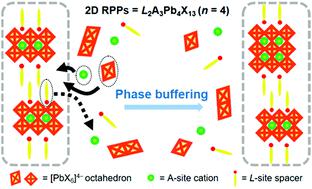当前位置:
X-MOL 学术
›
Energy Environ. Sci.
›
论文详情
Our official English website, www.x-mol.net, welcomes your
feedback! (Note: you will need to create a separate account there.)
Imidazole additives in 2D halide perovskites: impacts of –CN versus –CH3 substituents reveal the mediation of crystal growth by phase buffering
Energy & Environmental Science ( IF 32.4 ) Pub Date : 2022-06-07 , DOI: 10.1039/d2ee00571a Shuang Yu 1 , Jie Meng 2 , Qinying Pan 3 , Qian Zhao 2 , Tõnu Pullerits 3 , Yingguo Yang 4 , Kaibo Zheng 2 , Ziqi Liang 1
Energy & Environmental Science ( IF 32.4 ) Pub Date : 2022-06-07 , DOI: 10.1039/d2ee00571a Shuang Yu 1 , Jie Meng 2 , Qinying Pan 3 , Qian Zhao 2 , Tõnu Pullerits 3 , Yingguo Yang 4 , Kaibo Zheng 2 , Ziqi Liang 1
Affiliation

|
The unique sandwich structure and favorable crystallization kinetics have endowed two-dimensional (2D) halide perovskites with excellent ambient stability and facile film formation compared to those of their three-dimensional counterparts. However, the heterogeneous crystallization of multiple n-value phases during solution-casting of 2D perovskite thin films results in random and disordered crystalline alignment in conjunction with numerous lattice defects, all of which ultimately impair the device performance. Herein we demonstrate that highly ordered lattice arrangements in 2D lead halide perovskites, exemplified as a paradigm phenylethylamine (PEA) spacer, can be achieved using the 4,5-dicyanoimidazole (DCI) additive without any post-treatment. Electrostatic potential distribution mapping and X-ray photoelectron spectroscopy collectively confirm the Lewis acid–base interaction between –CN− units in DCI and Pb2+, which is conducive to homogeneous nucleation during perovskite crystallization. A sequence of in situ grazing-incident wide-angle X-ray scattering and high-resolution transmission electron microscopy characterization unravel the epitaxial growth of multi-phases that gradually buffer the internal lattice strain and consequently regulate the lattice orientation, which markedly leads to a reduction of trap density and a prolongation of carrier lifetime. The resulting planar solar cells based on 2D PEA2MA3Pb4I13 (n = 4) deliver an outstanding efficiency of ∼17.0% along with excellent operational stability.
中文翻译:

2D 卤化物钙钛矿中的咪唑添加剂:-CN 与 -CH3 取代基的影响揭示了相缓冲对晶体生长的调节作用
与三维对应物相比,独特的夹层结构和有利的结晶动力学赋予二维(2D)卤化物钙钛矿优异的环境稳定性和易于成膜。然而,多个n的异质结晶二维钙钛矿薄膜溶液浇铸过程中的 - 值阶段导致随机和无序的晶体排列以及许多晶格缺陷,所有这些最终都会损害器件性能。在这里,我们证明了二维卤化铅钙钛矿中高度有序的晶格排列,例如作为范式苯乙胺 (PEA) 间隔物,可以使用 4,5-二氰基咪唑 (DCI) 添加剂实现,无需任何后处理。静电势分布图和 X 射线光电子能谱共同证实了 DCI 中的 -CN -单元与 Pb 2+之间的路易斯酸碱相互作用,这有利于钙钛矿结晶过程中的均匀成核。原位序列掠入射广角 X 射线散射和高分辨率透射电子显微镜表征揭示了逐渐缓冲内部晶格应变并因此调节晶格取向的多相的外延生长,这显着导致陷阱密度降低和载流子寿命的延长。由此产生的基于 2D PEA 2 MA 3 Pb 4 I 13 ( n = 4) 的平面太阳能电池具有 17.0% 的出色效率和出色的运行稳定性。
更新日期:2022-06-07
中文翻译:

2D 卤化物钙钛矿中的咪唑添加剂:-CN 与 -CH3 取代基的影响揭示了相缓冲对晶体生长的调节作用
与三维对应物相比,独特的夹层结构和有利的结晶动力学赋予二维(2D)卤化物钙钛矿优异的环境稳定性和易于成膜。然而,多个n的异质结晶二维钙钛矿薄膜溶液浇铸过程中的 - 值阶段导致随机和无序的晶体排列以及许多晶格缺陷,所有这些最终都会损害器件性能。在这里,我们证明了二维卤化铅钙钛矿中高度有序的晶格排列,例如作为范式苯乙胺 (PEA) 间隔物,可以使用 4,5-二氰基咪唑 (DCI) 添加剂实现,无需任何后处理。静电势分布图和 X 射线光电子能谱共同证实了 DCI 中的 -CN -单元与 Pb 2+之间的路易斯酸碱相互作用,这有利于钙钛矿结晶过程中的均匀成核。原位序列掠入射广角 X 射线散射和高分辨率透射电子显微镜表征揭示了逐渐缓冲内部晶格应变并因此调节晶格取向的多相的外延生长,这显着导致陷阱密度降低和载流子寿命的延长。由此产生的基于 2D PEA 2 MA 3 Pb 4 I 13 ( n = 4) 的平面太阳能电池具有 17.0% 的出色效率和出色的运行稳定性。











































 京公网安备 11010802027423号
京公网安备 11010802027423号